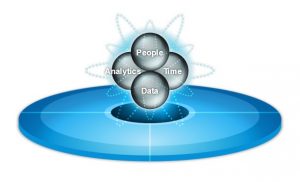Analytics provides better insights into why something happened, or helps provide decision makers with information about what will happen in the future. That allows organizations to act now to improve outcomes instead of reacting to events after they happen.
But it takes more than analytics alone. Achieving this level of insight requires analytics in action.  That means:
That means:
- You can quickly transform raw data so that it can be efficiently processed by analytic algorithms.
This requires: Data access; the ability to profile the data; clean up data quality issues; and then store the data in an analytic base table ready for data scientists to go at it. Planning for data storage, data processing, and governance of the data. - You have the proper analytics (or combination of analytics) to answer the business question at hand.
Is it a data mining issue, a forecasting issue, a optimization issue, or a combination of two or all three? - You have the right people.
You need employees who can work together across IT and the business units, analytics experts, and an executive champion for using analytics. - You can take action on your findings in a timely manner.
You must be able to put your results into a production business process flow.
If any one of these ingredients is missing, you'll either struggle to provide value or outright fail. Let's look at what happens if you're missing any of these key elements.
If you're missing No. 1 (data) then your analysts will spend too much time trying to pull data together. That limits the time for analysis. As a result, data insights won't make it to managers and executives in time to help them make better decisions.
If you're missing No. 2 (analytics) then the only information you can provide is what happened in the past. You'll miss out on why it happened, or how it might be avoided in the future. As a result, you'll be running your organization based on yesterday's performance instead of optimizing how well you could execute tomorrow.
If you're missing No. 3 (people) then even if you have No. 1, 2 and 4, it's unlikely that you'll provide meaningful value for your business. You must have the right people to execute your analytics strategy.
If you're missing No. 4 (time) then you're in a frustrating situation. You're failing only because the process for integrating your insights are flawed in some way. It's usually either a cultural issue that prevents you from changing processes, or a technology that limits your ability to embed your insights into production systems.
For more than 40 years, SAS has been helping customers just like you put analytics in action and solve their most pressing business issues. SAS provides an open framework that makes it easier for a wide range of people to perform analytical data management and world leading analysis. We also help ensure you have the right education and services needed to make you and your organization become more successful using analytics than ever before.
